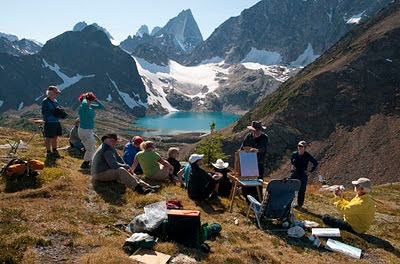The weather gods smiled on us this year for our 2nd heli-painting trip into the Bugaboo mountains of British Columbia. We had 3 days of bluebird skies- spectacular! Tamarak Glen is an especially powerful location with so many compositions it's a challenge to narrow it down - the requests rolled in for more time here next year.
For those of you wondering how this kind of a trip works - here's the goods:
The accommodation is a gorgeous lodge in the most unlikely backcountry wilderness with private rooms, queen size beds and feather duvets. The cuisine is 5 star, and all the painters gather for dinner each night to share and relive the day's adventures. The lodge also has a hot tub on the roof, so often the conversation continues while floating around under a starlit sky. This year there were stars, a full moon and Northern Lights - pretty nearly perfect.
Robert Genn painting at Pearl
Each day we fly by helicopter to one or two magnificent locations, and once we have been deposited and the heli has left, the painting begins. Robert and I do demos and lots of circulating and giving feedback and pointers, but the priority is painting time for the artists, and often we all just paint together as a group.
Nathan Cao, Bob Genn and Don Hodgins on Rocky Point Ridge.
There are two things I've noticed each year we have immersed ourselves in this truly unique environment to paint - the artists improve in leaps and bounds, and a wonderful bond forms between the group that is fostered by engaging in a shared experience filled with camaraderie, challenge and heart-stoppingly beautiful inspiration.
Robert about to demo on Black Forest Ridge
Each painter develops a whole lot of work, anywhere from 5-15 studies each, and on the last night we gather them all together for review and critique. It is truly moving to see well over 100 paintings created in 3 days by one group of artists. So cool to observe the incredibly varied ways of seeing the same landscape, and each person's clear progress from beginning to end as they find their feet and became more deeply connected with the environment.
 The crew - 2011.
The crew - 2011. Heli-painting is a truly extraordinary adventure. If you'd like to join us next year, more details can be found here.
Please log on to my Flickr link if you want to see more photos from this year's trip. (Make sure you click on slideshow view to see the best quality images.)
Paintings from the trip coming soon!




















